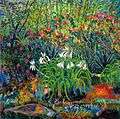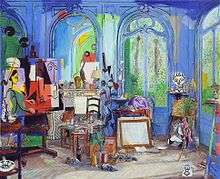Damian Elwes
| Damian Elwes | |
|---|---|
| Born |
Dusan Damian Cary Elwes[1] 10 August 1960[1] London, England |
| Residence | Santa Monica, California |
| Citizenship | British |
| Occupation | Artist |
| Parent(s) |
Dominic Elwes Tessa Kennedy |
| Website |
damianelwes |
Damian Elwes (born 10 August 1960) is a British artist who lives and works in Santa Monica, California. His paintings explore themes such as the cycle of life, creativity and the connections between all living things. His artwork can be monumental and three-dimensional, such as a painting in which visitors walk from room to room on the ground floor of the "Villa La Californie "(2006), to witness the extent of Picasso's creativity in April 1956 or an immense landscape painting on the ground, "Amazon" (1999), on which visitors can walk above the flowering plants of a cloud forest and search for the source of the river.

Education
Elwes was born in London into a family of artists. His grandfather and father were portrait painters. Both died when Damian was fifteen and left him easels and brushes. He was born to portrait-painter Dominic Elwes[2] and interior designer and socialite Tessa Kennedy. His brothers are Cary Elwes, an actor, and Cassian Elwes, an independent film producer. His ability in Mathematics helped him gain a place at Harvard University. At graduation, his play writing professor gave him a palette knife that had once belonged to Henri Matisse.[3] He went to Paris where, for two years, he made paintings of the studios of contemporary artists as a way to learn from them.
Work

In the 1980s, Elwes lived in New York, where he was an early exponent of graffiti. In 1984 some of his first paintings were chosen by the eminent London art dealer, Robert Fraser, to be included in a graffiti exhibition with Jean-Michel Basquiat and Keith Haring.[4]
His interest in ancient and contemporary methods of art making led him to spend time in Italy and Morocco. From 1992–2000, he lived, with his wife, Lewanne, in southern Colombia in a house and studio that he built overlooking a rain forest. There he created four "dream-sites", paintings so large that viewers can walk around inside them. A floor painting, "Fallen Tree" (1997) describes the cycle of life in one of the last surviving forests of mahogany. In a clearing in the forest, one old tree has fallen to the ground and is decaying. New saplings can be seen growing from the dead tree. This same cycle exists in painting and in all forms of innovation. So, while this work might be seen as a spur for conscience, it also contains an indication of Elwes' confidence in the power and continuity of creativity.[5] In London, 2010, Damian Elwes exhibited an even larger floor painting about the origin of life. That artwork depicts a primary source of the Amazon River which exists at the summit of a Colombian volcano called Puracé. The painting was placed under plexiglass in the gallery and visitors could walk all over it. For the surrounding walls, Elwes created contemporary cave paintings of a woman asleep in that exotic ecosystem.[6]

A documentary, 'Inside Picasso's Studio' (2006) follows Elwes as he creates a vast painting describing the various studios on ground floor of Picasso's "Villa La Californie", as they were in April 1956. The painting wraps around several walls and viewers are able to walk from room to room while examining hundreds of Picasso's artworks in progress. Curator Fred Hoffman wrote, "While we, the viewer, are immediately intrigued and invited to partake of these historical moments, what actually sustains, even heightens our interest, is Damian Elwes' ability to turn documentation and historical record into compelling pictorial visions requiring repeated viewing and constant deciphering. Elwes' concern for historical accuracy, and his subsequent investigative process enable his fully realized paintings to have a freshness and immediacy which none of the source material contains nor conveys. It is not, therefore, the fact that he has painted Picasso’s studio that makes Elwes' work of interest. Rather, it is his ability to use the historical source material about Picasso to achieve some immediacy for his own concerns as a painter. In the end, it is the expressive quality of these works that we feel drawn to."[7]

Series of Paintings
- Amazon, 1999 (Installation) A floor painting describes the kind of ecosystem which existed millions of years before humans and which is likely to exist millions of years from now.
- Fallen Tree, 1998 (Installation) A floor painting which demonstrates how the cycle of life in a primary forest of mahogany is similar to the life cycle of man.
- Forest of Statues, 1998 (Installation) 12 panels form a circular 360-degree painting of a forest where early humans have left carved statues.
- Bull Paintings, 1993–2014 Meditations about the significance of cave paintings are brought to life because at 9 years old Elwes was gored and almost killed by a Spanish fighting bull.
- Edge of the Forest, 1997 (Installation) 12 panels join together to form a square 360-degree painting. Viewers find themselves in an ancient garden with a house on one side and a forest on the other.
- Paintings of Byron, Keats and Shelley in Italy, 1992-3
- Paintings of the studios of 19th Century Masters, 2002–2004
- Paintings of the studios of 20th Century Masters, 2004–12
- Picasso's Villa La Californie, 2006-2012 (Installation) 8 panels connect and wrap around three walls. This painting describes a moment of intense human creativity.
- Women, 2010–12 These were created to be shown with the Amazon painting to indicate that the painting is about the source of life. In the mythology of some Amazonian tribes, the source of the river is the first woman and all life comes from her.
Exhibitions
- Francis Naumann Fine Art, 22 October - 15 December 2004[8]
- M&B Fine Art, 2 March - 15 May 2006[9]
- Lefevre Fine Art, 6 June - 4 July 2008[10]
Gallery
-

Gauguin's Studio in Tahiti2007
-

Source of the Amazon-gallery installation
-

Forest of Statues VI, 1998
-

Edge of the Forest 10 (part of a 360-degree landscape painting) 1997
-

Bull l, 1993
References
- 1 2 "Damian Elwes - Biography - IMDb". IMDb. Retrieved 16 July 2014.
- ↑ Cerio, Gregory (6 February 1995). "A Hero to the Hilt". People. Archived from the original on 26 September 2011. Retrieved 26 September 2011.
- ↑ Francis Naumann, Damian Elwes The Studios of Matisse, Picasso, Warhol and Duchamp, Francis Naumann Fine Art, New York, 2004.
- ↑ ‘Paris-New York’ ‘ Robert Fraser Gallery at The Fruitmarket Gallery (Edinburgh) 11 August – 23 September 1984.
- ↑ 'Forest of Statues', Richard Salmon Gallery, London, 5 August – 15 September 1998
- ↑ Serena Morton. "Serena Morton - Exhibitions". Agentmorton.com. Retrieved 2014-03-25.
- ↑ Fred Hoffman, Damian Elwes and the Modernist Heritage (M&B Fine Art, 2006)
- ↑ francisnaumann.com, retrieved 15 September 2011
- ↑ artscenecal.com, retrieved 15 September 2011
- ↑ lefevrefineart.com, retrieved 15 September 2011
External links
- Official website
- Francis M. Naumann Fine Art
- "Lefevre Fine Art"
- The Independent
- M + B Fine Art
- Damian Elwes at the Internet Movie Database
